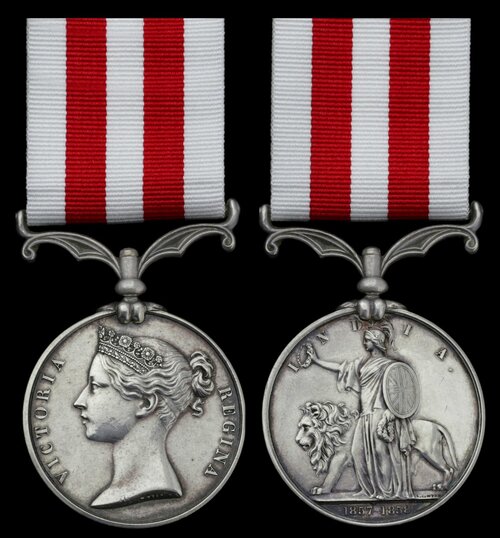Bombay Staff Corps - A two-part waist belt clasp, 1855 pattern but with acanthus finials, centrally the crown over 'VR' and unit title in surround, matching bench marks 'XXXVIII', together with one only small officer's gilt tunic button to the same unit, c. 1856-1901.Indian Staff Corps was a branch of the British Indian Army during Colonial rule. Separate Staff Corps were formed in 1861 for the Bengal, Madras and Bombay Armies, which constituted the Indian Army, although they were later amalgamated. They were meant to provide officers for the native regiments, and for the staff and army departments. They were also designed to offer placements for civil and political appointments for posts for which Indian Army officers might be eligible. Those officers who were already employed by the Army had the option to join the Staff Corps or to stay employed under the old conditions of work. In that sense it was seen by the majority of post-1860 entrants as synonymous with the Regular Officer Corps of the Indian Army. 109th Bombay Infantry (Central India) -An officer's waistbelt clasp, bi-metal, gilt finish, bearing regimental device109th Regiment of Foot (Bombay Infantry) was an infantry regiment of the British Army from 1862 to 1881, when it was amalgamated into The Prince of Wales's Leinster Regiment (Royal Canadians).The regiment was originally raised by the Honourable East India Company in 1853 as the 3rd Bombay (European) Regiment, and served in the Indian Mutiny of 1857. As with all other "European" units of the Company, they were placed under the command of the Crown in 1858, and formally moved into the British Army in 1862, ranked as the 109th Foot. As part of the Childers Reforms in 1881, the regiment was amalgamated with the 100th (Prince of Wales's Royal Canadian) Regiment of Foot to form The Prince of Wales's Leinster Regiment (Royal Canadians). Black Watch Volunteers Regiment - An officer's waistbelt clasp, 19th Century, bearing regimental device.Black Watch was formed as part of the Childers Reforms in 1881 when the 42nd (Royal Highland) Regiment of Foot (The Black Watch) was amalgamated with the 73rd (Perthshire) Regiment of Foot to form two battalions of the newly named Royal Highlanders (The Black Watch). The 1st Battalion then served in Africa taking part in the Highland Brigade's dawn assault on the Egyptian position at Tel-el-Kebir in 1882. Two years later it was in the thick of the fight with the Mahdi's tribesmen at El Teb and Tamai. The following year (1885) saw it taking part in the Nile Expedition and fighting at Kirbekan and Abu Klea. 18th Regiment of Foot - An officer's waistbelt clasp, bi-metal, 19th Century, bearing regimental device, (4)
Bombay Staff Corps - A two-part waist belt clasp, 1855 pattern but with acanthus finials, centrally the crown over 'VR' and unit title in surround, matching bench marks 'XXXVIII', together with one only small officer's gilt tunic button to the same unit, c. 1856-1901.Indian Staff Corps was a branch of the British Indian Army during Colonial rule. Separate Staff Corps were formed in 1861 for the Bengal, Madras and Bombay Armies, which constituted the Indian Army, although they were later amalgamated. They were meant to provide officers for the native regiments, and for the staff and army departments. They were also designed to offer placements for civil and political appointments for posts for which Indian Army officers might be eligible. Those officers who were already employed by the Army had the option to join the Staff Corps or to stay employed under the old conditions of work. In that sense it was seen by the majority of post-1860 entrants as synonymous with the Regular Officer Corps of the Indian Army. 109th Bombay Infantry (Central India) -An officer's waistbelt clasp, bi-metal, gilt finish, bearing regimental device109th Regiment of Foot (Bombay Infantry) was an infantry regiment of the British Army from 1862 to 1881, when it was amalgamated into The Prince of Wales's Leinster Regiment (Royal Canadians).The regiment was originally raised by the Honourable East India Company in 1853 as the 3rd Bombay (European) Regiment, and served in the Indian Mutiny of 1857. As with all other "European" units of the Company, they were placed under the command of the Crown in 1858, and formally moved into the British Army in 1862, ranked as the 109th Foot. As part of the Childers Reforms in 1881, the regiment was amalgamated with the 100th (Prince of Wales's Royal Canadian) Regiment of Foot to form The Prince of Wales's Leinster Regiment (Royal Canadians). Black Watch Volunteers Regiment - An officer's waistbelt clasp, 19th Century, bearing regimental device.Black Watch was formed as part of the Childers Reforms in 1881 when the 42nd (Royal Highland) Regiment of Foot (The Black Watch) was amalgamated with the 73rd (Perthshire) Regiment of Foot to form two battalions of the newly named Royal Highlanders (The Black Watch). The 1st Battalion then served in Africa taking part in the Highland Brigade's dawn assault on the Egyptian position at Tel-el-Kebir in 1882. Two years later it was in the thick of the fight with the Mahdi's tribesmen at El Teb and Tamai. The following year (1885) saw it taking part in the Nile Expedition and fighting at Kirbekan and Abu Klea. 18th Regiment of Foot - An officer's waistbelt clasp, bi-metal, 19th Century, bearing regimental device, (4)





/85918/Internet%20Image%201.jpg)





/76009/Internet%20Image%201.jpg)
/122117/Internet%20Image%201.jpg)


Try LotSearch and its premium features for 7 days - without any costs!
Be notified automatically about new items in upcoming auctions.
Create an alert